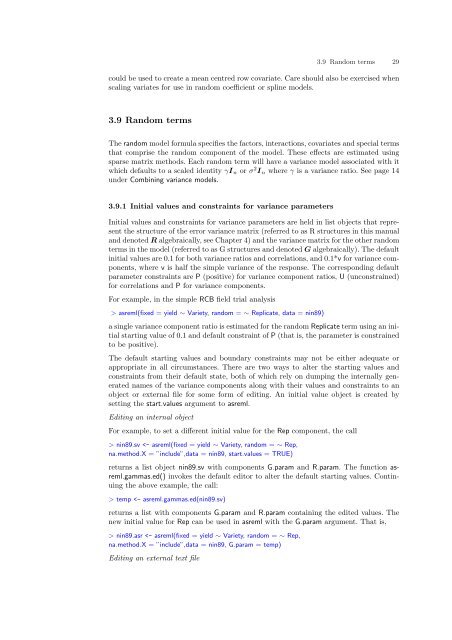ASReml-S reference manual - VSN International
ASReml-S reference manual - VSN International
ASReml-S reference manual - VSN International
- No tags were found...
Create successful ePaper yourself
Turn your PDF publications into a flip-book with our unique Google optimized e-Paper software.
3.9 Random terms 29could be used to create a mean centred row covariate. Care should also be exercised whenscaling variates for use in random coefficient or spline models.3.9 Random termsThe random model formula specifies the factors, interactions, covariates and special termsthat comprise the random component of the model. These effects are estimated usingsparse matrix methods. Each random term will have a variance model associated with itwhich defaults to a scaled identity γI n or σ 2 I n where γ is a variance ratio. See page 14under Combining variance models.3.9.1 Initial values and constraints for variance parametersInitial values and constraints for variance parameters are held in list objects that representthe structure of the error variance matrix (referred to as R structures in this <strong>manual</strong>and denoted R algebraically, see Chapter 4) and the variance matrix for the other randomterms in the model (referred to as G structures and denoted G algebraically). The defaultinitial values are 0.1 for both variance ratios and correlations, and 0.1*v for variance components,where v is half the simple variance of the response. The corresponding defaultparameter constraints are P (positive) for variance component ratios, U (unconstrained)for correlations and P for variance components.For example, in the simple RCB field trial analysis> asreml(fixed = yield ∼ Variety, random = ∼ Replicate, data = nin89)a single variance component ratio is estimated for the random Replicate term using an initialstarting value of 0.1 and default constraint of P (that is, the parameter is constrainedto be positive).The default starting values and boundary constraints may not be either adequate orappropriate in all circumstances. There are two ways to alter the starting values andconstraints from their default state, both of which rely on dumping the internally generatednames of the variance components along with their values and constraints to anobject or external file for some form of editing. An initial value object is created bysetting the start.values argument to asreml.Editing an internal objectFor example, to set a different initial value for the Rep component, the call> nin89.sv temp nin89.asr
















